The best time to Manaslu Circuit Trek
The best time for Manaslu Circuit Trek is during the Autumn season (September to November), widely regarded as the peak trekking season in Nepal. This period offers ideal trekking conditions with clear blue skies, stable weather, and moderate temperatures perfect for enjoying the awe-inspiring Himalayan landscapes.
During autumn, the Manaslu weather is crisp and predictable, offering stunning mountain views and dry trails. The days are pleasantly warm for walking, while nights can get quite chilly so be sure to pack appropriate cold-weather clothing for higher altitudes.
However, this season also sees a high influx of trekkers. As the Manaslu Circuit Trek becomes increasingly popular, expect busier trails, especially around key villages like Samagaon, Lho, and Dharapani. Tea houses and lodges fill up quickly, so advance booking is highly recommended to ensure accommodation and a smooth trekking experience.
Another excellent time to trek is in Spring (March to May). With blooming rhododendron forests, mild temperatures, and fewer crowds compared to autumn, spring provides a colorful and vibrant trekking atmosphere. The Manaslu trekking route is alive with the colors of nature, and the panoramic views of snow-capped peaks remain just as magical.
Do note that even in spring, cold nights are common especially above 3,000 meters. Make sure to bring warm layers, thermal gear, and a quality sleeping bag to stay protected against the chill.
Summary of Trekking Seasons:
| Season | Months | Highlights | Considerations |
|---|
| Autumn | Sept – Nov | Clear skies, stable weather, ideal views | Crowded trails, pre-booking needed |
| Spring | Mar – May | Blooming rhododendrons, pleasant weather, fewer crowds | Cold nights, possible haze late spring |
| Winter | Dec – Feb | Quiet trails, snow-covered mountains | Harsh cold, high passes may be blocked |
| Monsoon | Jun – Aug | Lush greenery, fewer trekkers | Landslides, slippery trails, poor visibility |
No matter which season you choose, the Manaslu Circuit Trek offers an unforgettable journey. Just be sure to plan according to the seasonal weather, your comfort with crowds, and your physical preparedness.
Manaslu Circuit Trek Permit and Costs (2025/26)
Trekkers are required to obtain three different permits for MCT Trek: the Manaslu Restricted Area Permit (MRAP), the Manaslu Conservation Area Permit (MCAP), and the Annapurna Conservation Area Permit (ACAP). These permits are mandatory as the trek passes through both restricted zones and protected conservation areas.
The Manaslu Restricted Area Permit (MRAP) is essential because the region between Jagat and Sama Gaun is classified as a restricted area by the Government of Nepal. The cost of the MRAP varies depending on the season. During the autumn season, from September to November, the permit fee is USD 100 per person for the first seven days. If you plan to stay longer, an additional fee of USD 15 per person per day is charged after the seventh day. In other seasons from December to August the cost drops to USD 75 for the first week, and USD 10 per day beyond that. It’s important to note that this permit must be issued through a registered trekking agency, and solo trekking is not allowed you must be part of a group with at least two trekkers and a licensed guide.
The Manaslu Conservation Area Permit (MCAP) costs USD 30 per person and is valid for the entire duration of your trek within the Manaslu Conservation Area. It supports conservation and local development efforts in the region and is required regardless of the length of your stay.
As the Manaslu Circuit Trail exits through the Annapurna region, you will also need the Annapurna Conservation Area Permit (ACAP). This permit also costs USD 30 per person and allows you to enter and trek within the Annapurna Conservation Area for an unlimited number of days.
For a smooth trekking experience, ensure that all permits are obtained in advance and carried throughout the journey. These permits are non-refundable and non-transferable. For further details on how to apply, and a complete breakdown of trekking costs, you can refer to our updated guide on Manaslu Circuit Trek Permits and Costs 2025/26.
Food and Accommodation
Food and accommodation for the Manaslu Circuit Trek are facilitated by teahouses on the trail. Every night of the Manaslu trek is spent in teahouses. These teahouses have two single beds for basic lodging. Most have communal restrooms, which are usually outside. The dining area is a single space with heating.
The most common food served along the trek is traditional Nepali cuisine. It consists of rice, veggies, pulses, and pickles. You can find appetizing meals such as stir-fried noodles, soft flatbreads, hot soup, and muesli. Also, when it comes to drinking, you can get basic options like it's tea, coffee, water, and less variety of cold drinks.
These tea houses give you basic facilities. Most of the tea houses also have Wi-Fi facilities. But food and beverages are relatively more expensive in this remote setting.
People and Culture
Along with the scenic beauty of the Himalayas, you will also be able to encounter the colorful cultures and people on this trek. The communities of Brahmin, Magar, and Chettri are all represented on the way to the Manaslu Circuit. The upper region you'll trek through has some major ethnic groups. They are the Indo-Aryans from the south. The Mongoloids are from the north. And the Tibeto-Burmans.
Likewise, you will come across the Tsum and Nubri communities if you are hiking in the Tsum Valley. The wide range of people living in the Manaslu Trek region will wow you with their many tongues and practices.
Other Sino-Tibetan languages and Nepali are among the languages spoken in this region. The people who live in this area speak languages including Tsum, Nubri, Nepali, and Nepal Bhasa.
Manaslu Circuit Trek Difficulty
Do you know how difficult the Manaslu Circuit Trek is? Is everyone able to accomplish this trek?
The Manaslu Circuit trek is famous for its extreme degree of difficulty. There are unique difficulties when trekking at high altitudes. You'll come across a range of terrain in isolated and untamed environments, from rocky roads to steep inclines. But, each person's level of endurance will determine how challenging the task is for them. Trekkers who are new to the sport may need help finding the routes.
But all adventurers may handle this trek if they've had prior experience and prepared well. Since the walk usually takes five to six hours each day, high-altitude training must be completed in advance. This training program should ideally begin two months or at least two weeks before the walk and helps increase strength, endurance, and general fitness.
Additionally, there is a chance of developing serious mountain sickness due to the high altitude. Along the paths, preventive measures include maintaining a balanced diet, staying hydrated, and properly acclimatizing. To avoid Manaslu Circuit trek altitude sickness, some hikers may choose to take "Diamox tablets".
Proper packing is crucial for an unforgettable trip. Hiking with gear and equipment may seem stressful at first, but you will become used to it with experience. All things considered, even though the Manaslu Circuit Trek offers a very severe difficulty level, it's a positive experience that may be guaranteed with enough planning, training, and willpower.
Hire a Guide and Porter Mandatory and Incredibly Helpful
Trekking the Manaslu Circuit without a guide is not permitted. Since the Manaslu region is a restricted area, the Nepalese government mandates that all trekkers be accompanied by a licensed local guide, and you must trek in a group of at least two people. Additionally, your permits must be arranged through a registered trekking agency in Nepal.
Hiring a guide is not just about fulfilling legal requirements, it's an invaluable asset to your trekking experience. A professional guide helps with navigation, ensures your safety in case of altitude sickness or poor weather, and offers fascinating cultural insights, especially in Tibetan Buddhist villages like Lho, Samagaun, and Samdo. Porters are also recommended; they can carry up to 25 kg of gear, allowing you to enjoy the trek without being weighed down.
Expect to pay around $25–30 USD/day for a guide, and $18–25 USD/day for a porter. Be sure to tip them well at the end of your trek.
Carry Enough Cash, No ATMs Beyond Kathmandu
Once you leave Kathmandu, you won’t find any reliable ATMs on the Manaslu trek route. Even larger settlements like Jagat, Samagaun, and Bimthang lack banking services. That means all expenses, meals, accommodation, snacks, charging, Wi-Fi, and porter/guide tips must be paid in cash.
Most trekkers spend $25–35 per day, so for a 15-day trek, it’s smart to carry at least $500–600 USD in Nepali Rupees. Withdraw your cash in Thamel, Kathmandu, where ATMs are plentiful. Make sure to bring smaller denominations (100s or 500s), as locals may not have change for larger bills.
Fitness is required for the trek
Trekking on trails of the Manaslu Circuit requires a lot of strength and stamina. This is because it involves traveling through rough terrain at many different altitudes. It involves traveling via rural areas, climbing steep hills, and sometimes coming across bad weather, especially at the intimidating Larkya Pass. You should prepare for a 6-to-8-hour daily hike that may exhaust your lower body.
The Manaslu Circuit Trek, despite its challenges, offers deep cultural experiences in Nepal's remote regions, together with breathtaking views of majestic peaks. Consider it a priority to prepare yourself. Do so by being fit and enduring. Follow a regular fitness and endurance schedule. To become used to the demands of this intense walk, it's recommended to go on preparatory walks for ten to fifteen days.
Electricity on the Manaslu Circuit Trek
While on the trek, there is access to electricity, but it is not wholly reliable. Since most tea houses have solar panels, there may occasionally be an electrical shortage caused by insufficient sunlight. To save it for the night, several tea houses also turn off the electricity. As you climb, though, the owners of the tea houses typically charge you USD 1 or 2 per hour for charging your batteries.
It is recommended to carry one or two spare batteries with you at all times. If not, you can travel with portable solar panels and power banks. Another way to conserve battery life is to keep your phone in flight mode and battery saver.
Electricity and Mobile Signal Limited Beyond Samagaun
While electricity is generally available in the lower villages (via micro-hydro or solar), it becomes scarce as you gain altitude especially after Samagaun. In places like Dharmasala or Larke Phedi, there may be no electricity at all, or charging may cost NPR 200–500 per device. To stay powered up, bring a large power bank (10,000–20,000 mAh) or a solar charger if you plan to trek longer.
Mobile phone signals (Ncell or NTC) are intermittent after Namrung and typically nonexistent after Samdo. Some teahouses in Samagaun offer paid Wi-Fi, but don’t rely on it. For safety, consider carrying a satellite communication device like a Garmin InReach or a SPOT messenger.
Side Trips from the Main Manaslu Trail
The Manaslu Circuit Trek is already one of Nepal’s most scenic and culturally rich routes, but adding a few side trips can take your adventure to the next level. These optional day hikes offer stunning views, cultural experiences, and the chance to explore quieter, lesser-traveled trails. Here are some of the best side trips you can take along the Manaslu Circuit:
Pungyen Gompa (near Samagaun) sits at an elevation of around 4,000 meters and can be reached in a 4–5 hour round trip. This beautiful monastery is located in a wide glacial valley, offering jaw-dropping views of Mt. Manaslu and its surrounding peaks. The hike passes through peaceful yak pastures and provides an excellent opportunity for acclimatization before ascending higher.
Manaslu Base Camp (from Samagaun) lies at approximately 4,800 meters and requires a challenging 6–8 hour round-trip hike. Best suited for those who are well-acclimatized, this trek rewards hikers with panoramic views of Manaslu, towering glaciers, and dramatic alpine scenery. Due to the altitude, proper acclimatization and fitness are essential.
Birendra Tal (near Samagaun) is a glacial lake situated at around 3,450 meters. The walk to the lake takes only 1–2 hours round trip, making it an ideal choice for a rest day or a light acclimatization hike. The lake sits beneath sheer cliffs and is fed by the meltwater of the Manaslu Glacier.
Hinang Gompa and Glacier (from Lho) is located at an elevation of around 3,700 meters and can be reached in about 4–5 hours round trip. This serene side trip leads you through forests and alpine pastures to a quiet, ancient monastery with a close-up view of the Hinang Glacier. It’s a spiritually enriching and less-crowded alternative along the trail.
Kal Tal (from Prok Village) also rests at approximately 3,700 meters and involves a more strenuous 6–7 hour round-trip hike. This hidden alpine lake offers tranquility, lush forest trails, and a true off-the-beaten-path adventure. The climb is tough but well worth the effort.
Rui La Pass (near Sama or Samdo, toward the Tibetan border) sits near 4,998 meters and requires a full-day hike. This high-altitude excursion brings you close to the Tibetan border, with sweeping views over Nepal and Tibet. Along the way, you’ll follow ancient trade routes and may spot blue sheep or even snow leopards if you're lucky.
Incorporating one or two of these side trips into your Manaslu Circuit trek will greatly enhance your experience, offering deeper insight into the region’s natural beauty and cultural richness.If you have additional time, consider extending your journey into the Tsum Valley. This remote and spiritually significant area takes 5–7 extra days to explore and features ancient Buddhist monasteries, secluded meditation caves, and a well-preserved Tibetan-influenced culture. Be aware that visiting Tsum Valley requires an additional permit.
Health & Safety Be Prepared for Altitude and Emergencies
Trekking the Manaslu Circuit means venturing into high-altitude terrain, with the trail reaching elevations above 5,000 meters. This brings a real risk of Acute Mountain Sickness (AMS), so preparation and awareness are essential for your safety.
To reduce the risk of AMS, always ascend gradually and take at least one acclimatization day — Samagaun is the most common and recommended spot for this. Staying properly hydrated is also crucial; aim to drink 3–4 liters of water each day. Avoid alcohol and heavy meals, especially at higher elevations, as they can worsen altitude-related symptoms.
It’s wise to carry Diamox (acetazolamide), a medication that can help prevent and ease the symptoms of AMS. Know the warning signs of altitude sickness, which include headache, nausea, dizziness, and loss of appetite. If symptoms worsen or persist, descend immediately.
There are no hospitals or advanced medical facilities along the trail. In case of a serious emergency, helicopter evacuation is the only viable option. Therefore, it is essential that your travel insurance covers high-altitude trekking and includes helicopter rescue.Being prepared, listening to your body, and respecting the altitude can make the difference between a successful trek and a dangerous situation.
Respect Local Culture & Trek Sustainably
The Manaslu region is inhabited primarily by ethnic Tibetan communities who maintain strong Buddhist traditions. As a visitor, showing respect for their culture and environment is essential to ensure a positive and responsible trekking experience.
Always walk clockwise around mani walls and stupas, as this practice aligns with Buddhist customs and is considered respectful. When photographing monks or local residents, ask permission first this honors their privacy and cultural sensitivities.
Dress modestly while in villages, making sure that shoulders and knees are covered, which reflects local norms and shows respect. Learning and using simple local greetings such as "Namaste" in Nepali or "Tashi Delek" in Tibetan helps build rapport and shows appreciation for the local culture.
Sustainability is equally important in this fragile mountain environment. Help protect the region by minimizing plastic use bring a reusable water bottle and purification tablets instead of relying on bottled water. Always carry out all non-biodegradable trash, and avoid using soaps or detergents in rivers or streams to prevent pollution of natural water sources.
By respecting cultural practices and trekking sustainably, you contribute to preserving the unique heritage and pristine environment of the Manaslu region for generations to come.
Photography Tips for the Manaslu Circuit
For content creators, Instagrammers, and passionate landscape photographers, the Manaslu Trek offers incredible opportunities to capture the region’s breathtaking beauty. This remote Manaslu Circuit Trekking Route showcases dramatic mountain vistas, vibrant local culture, and pristine natural scenery that make for unforgettable photographs.
Some of the top photography spots on the Manaslu trek include:
Lho Village at sunrise, where the glowing peak of Mt. Manaslu towers behind the village gompa, creating an iconic scene perfect for landscape and cultural shots.
Samagaun and Birendra Lake, known for their stunning glacial reflections, are must-visit locations for nature photographers.
Larke Pass, one of the highest points on the Manaslu Circuit at nearly 5,000 meters, offers sweeping panoramic views of the surrounding Himlung Himal, Cheo Himal, and Annapurna II peaks.
To make the most of your photography on the Manaslu trek, it’s essential to bring the right gear. A lightweight tripod helps stabilize your camera for crisp sunrise and sunset shots, while ND filters allow you to create silky smooth effects on waterfalls and rivers. Carry a dry bag to protect your camera equipment from rain, snow, and dust, which are common at high altitudes.
Respect for local culture in Manaslu is crucial: always ask permission before photographing monks or villagers, and be mindful of cultural sensitivities. Combining proper preparation with cultural respect will help you capture stunning images that showcase the unique charm and natural grandeur of the Manaslu region.

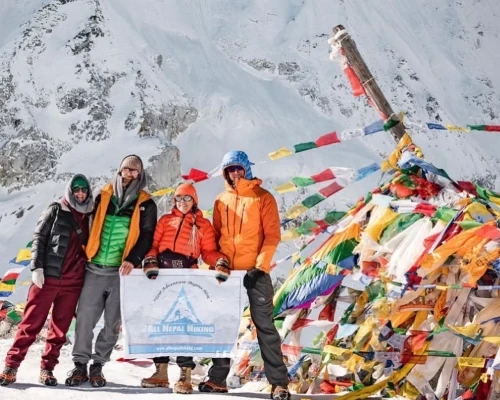
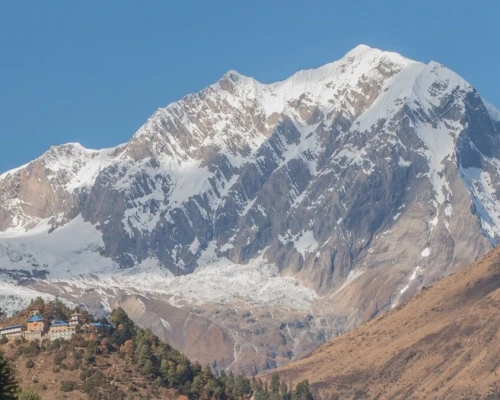

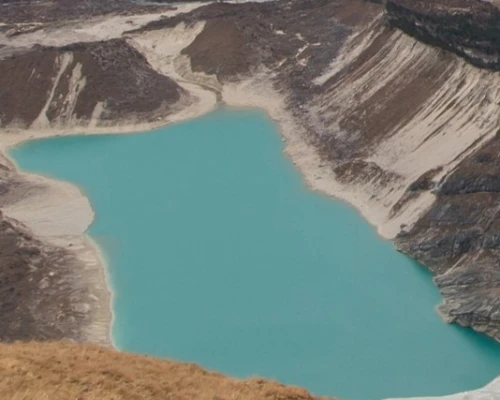

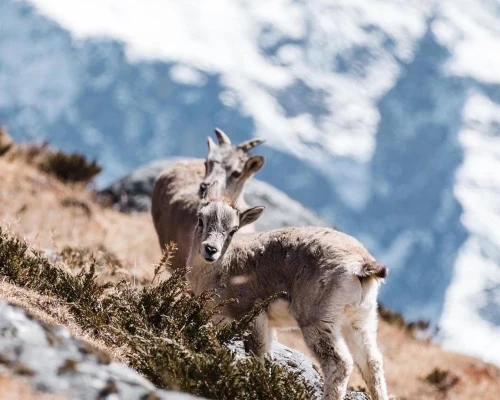
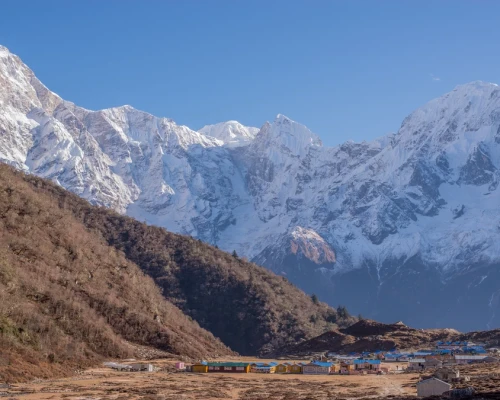
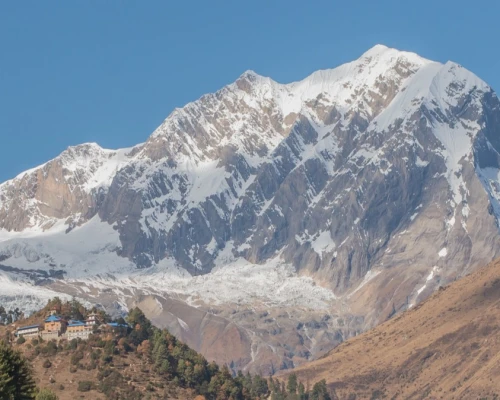
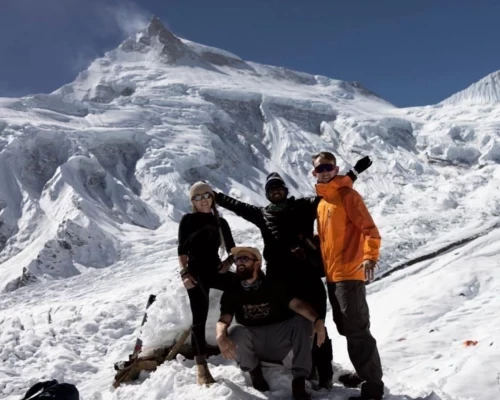
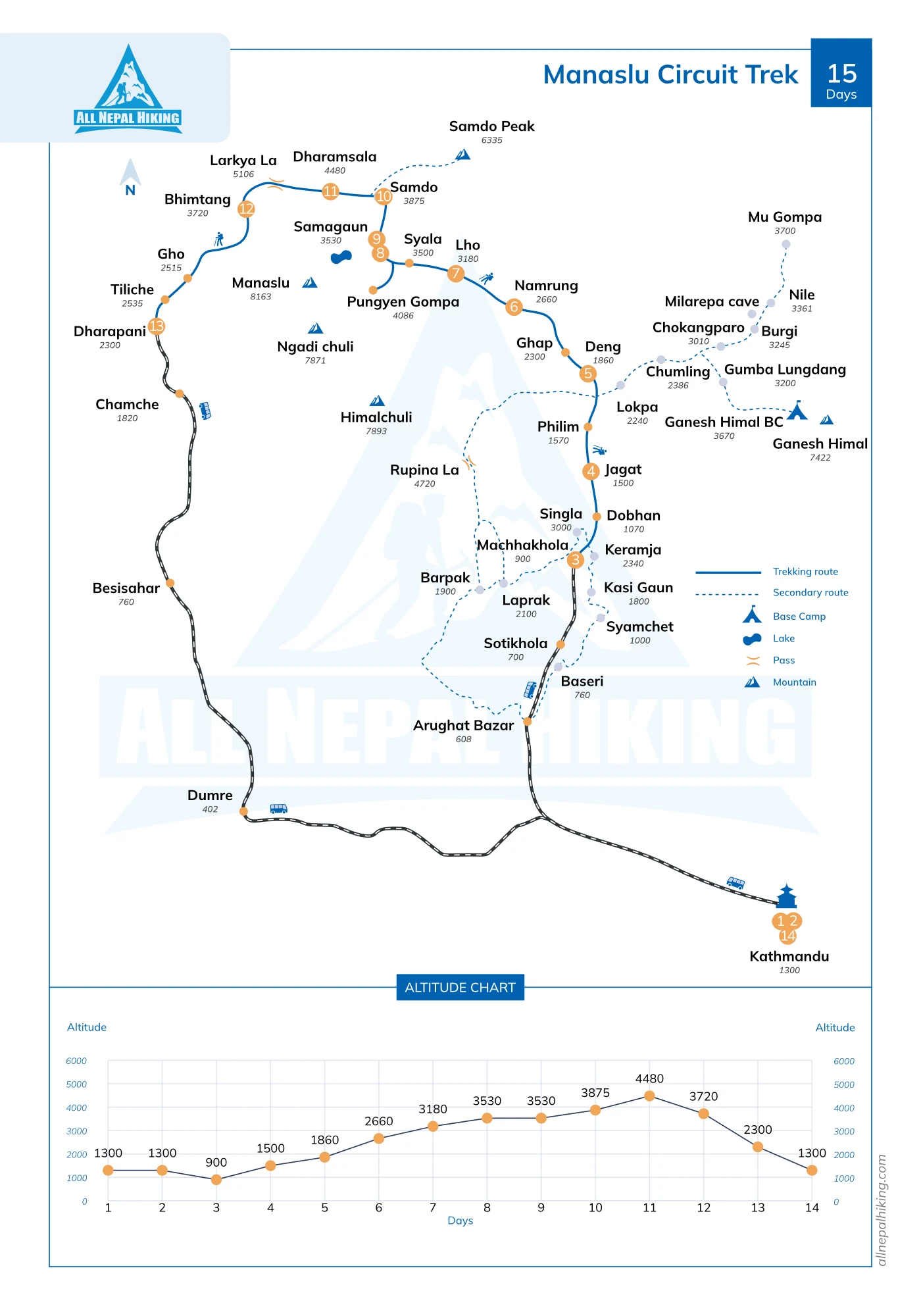
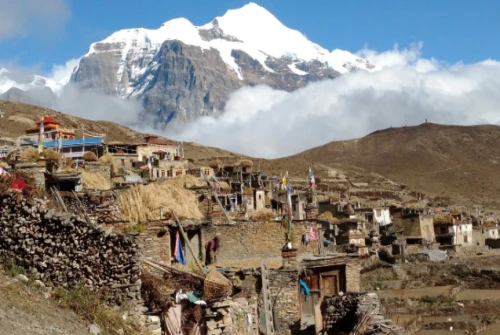

 based on 6 reviews
based on 6 reviews